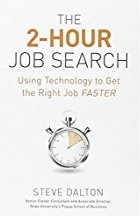Of course, no book is perfect (and so I have my quibbles with the two books below), but here are the two career-advice books I’m telling my students and anyone else they need to read!
 Designing Your Life, by Bill Burnett and Dave Evans (Knopf, 2016): Ostensibly, this book is about utilizing product design principles such as brainstorming, prototyping, etc. to help you plan your life. And it is. But, in my mind, the two greatest things about this book is (1) it tells you how to get unstuck, if you don’t know what to do for a career, and (2) it tells you how to do networking that enables you to figure out what to do and to find a position to enable you to do that kind of work. And, perhaps best of all, it tells you exactly how to go about getting unstuck, do networking, and the other tasks that Burnett and Evans describe. Unlike other books where the advice is so general as to be anodyne—”reach out to your network,” “come up with a list of options”—the authors tell you what kind of table or chart to create, what to write in one kind of email versus another, etc.
Designing Your Life, by Bill Burnett and Dave Evans (Knopf, 2016): Ostensibly, this book is about utilizing product design principles such as brainstorming, prototyping, etc. to help you plan your life. And it is. But, in my mind, the two greatest things about this book is (1) it tells you how to get unstuck, if you don’t know what to do for a career, and (2) it tells you how to do networking that enables you to figure out what to do and to find a position to enable you to do that kind of work. And, perhaps best of all, it tells you exactly how to go about getting unstuck, do networking, and the other tasks that Burnett and Evans describe. Unlike other books where the advice is so general as to be anodyne—”reach out to your network,” “come up with a list of options”—the authors tell you what kind of table or chart to create, what to write in one kind of email versus another, etc.
 The Two-Hour Job Search, by Steve Dalton (Ten Speed Press, 2012): Simple, step-by-step, and specific advice on how to use informational interviewing to efficiently and effectively find a job, including the vast majority of jobs which are never advertised. The “Two-Hour” in the title is no gimmick. Dalton shows you how to focus your job search so it’s productive rather than random shots in the dark. And, like the Burnett and Evans book, Dalton tells you exactly what to do: what emails to write, when to write the follow-up, etc. (H/T to Michael Kimball-Bryant for the recommendation!)
The Two-Hour Job Search, by Steve Dalton (Ten Speed Press, 2012): Simple, step-by-step, and specific advice on how to use informational interviewing to efficiently and effectively find a job, including the vast majority of jobs which are never advertised. The “Two-Hour” in the title is no gimmick. Dalton shows you how to focus your job search so it’s productive rather than random shots in the dark. And, like the Burnett and Evans book, Dalton tells you exactly what to do: what emails to write, when to write the follow-up, etc. (H/T to Michael Kimball-Bryant for the recommendation!)
In short, I wish I had read these two books when I started my career! Whether you’re just starting out on your career or are an old hand, you’ll gain skills and a system to come up with and find the career for you!
(Btw, no one gave me a copy of these books to read. I borrowed either the paper or audiobook I read/listened to from my local library. The cover images are from Amazon, with cropping. Last update of the post: December 1, 2017.)